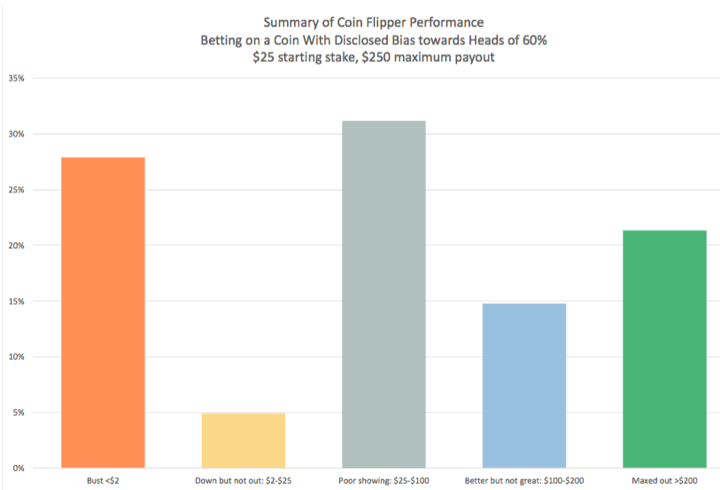 Here’s a very simple game that does a great job of illustrating the pitfalls of investing, despite the long-term odds being in your favor.
Here’s a very simple game that does a great job of illustrating the pitfalls of investing, despite the long-term odds being in your favor.
- Imagine that you are given $25 that you can bet on a coin toss for 30 minutes.
- You know that the coin will come up heads 60% of the time, and tails 40% of the time.
- You can bet as little or as much of your available cash on each flip. You double your wager if you are correct. You lose all of your wager if you are wrong.
There are many ways you could play this game. You could bet your entire $25 at once since you have an edge. But then there is a 40% chance you’d be instantly broke. You could bet nothing, as that would guarantee yourself $25 at the end of the session. You could vary your bets according to instinct. You could use mathematical theory to form an optimal solution.
Stock market investing works in a similar manner. People invest because the long-term odds are in our favor. Things look good over the long run, but there is volatility in the short run. Some people instead choose to take zero risk, but their money stagnates. Some people trade based on their intuition. Some people trade based on pre-set strategies.
The ideal result? If everyone bet optimally, they would have had a 95% chance of reaching 1000% of their initial wager (real-world maximum payout of $250). A mathematical formula called the Kelly Criterion tells you to bet a constant 20% of your bankroll every time. This is the optimal balance between the reward upside and keeping enough padding to avoid bankruptcy.
The actual results? The average ending balance was only $75. 33% of the participants actually lost money. 28% went completely broke! This comes from a research paper draft authored by Victor Haghani and Richard Dewey, who conducted this experiment on 61 “quantitatively trained test subjects” (appears to be finance workers that showed up for a hedge panel talk). Here’s a quote from the paper:
Given that many of our subjects received formal training in finance, we were surprised that the Kelly Criterion was virtually unknown and that they didn?t seem to possess the analytical tool-kit to lead them to constant proportion betting as an intuitively appealing heuristic. Without a Kelly-like framework to rely upon, we found that our subjects exhibited a menu of widely documented behavioral biases such as illusion of control, anchoring, over-betting, sunk- cost bias, and gambler?s fallacy.

That certainly sounds like real-world investing to me. Even in a situation with a clear advantage, people still mess it up all the time due to behaviorial and cognitive biases. People can argue whether volatility is a good proxy for risk, but the bottom line is that volatility in this game directly causes bad behavior. Big drops are always scary.
John Rekenthaler of Morningstar argues that the results of this experiment support the idea of auto-pilot investing.
My takeaways? Like this game, long-term investing is simple but not easy. You need to risk enough of your portfolio in order to expose yourself to the upside potential. However, you also need to keep enough safe such that you won’t flame out during a losing streak. I think that auto-pilot might work well in many situations, but people can also turn off autopilot in times of crisis if they don’t understand what’s “inside the box”. It’s best to calmly figure out an investment plan based on both market history and your personal situation, and then stick with it. Just winging it usually turns out poorly.
 The Best Credit Card Bonus Offers – 2025
The Best Credit Card Bonus Offers – 2025 Big List of Free Stocks from Brokerage Apps
Big List of Free Stocks from Brokerage Apps Best Interest Rates on Cash - 2025
Best Interest Rates on Cash - 2025 Free Credit Scores x 3 + Free Credit Monitoring
Free Credit Scores x 3 + Free Credit Monitoring Best No Fee 0% APR Balance Transfer Offers
Best No Fee 0% APR Balance Transfer Offers Little-Known Cellular Data Plans That Can Save Big Money
Little-Known Cellular Data Plans That Can Save Big Money How To Haggle Your Cable or Direct TV Bill
How To Haggle Your Cable or Direct TV Bill Big List of Free Consumer Data Reports (Credit, Rent, Work)
Big List of Free Consumer Data Reports (Credit, Rent, Work)
thank you for cheering us up, Jonathan, I’d briefly glanced on the overnight foreign markets and you did not want to see that 😉
Watching the ticker on CNBC is like watching the sign on top of the roulette wheel. Don’t invest with your gut. It has poop for brains. 🙂
Link to the game?
There used to be a live version, but it was taken down. If someone were to code something up, I’d be happy to link to it. You could even do it yourself using a random number generator.